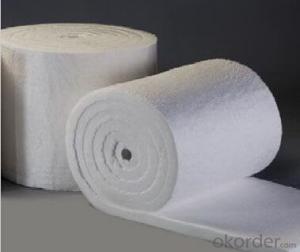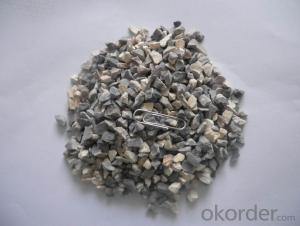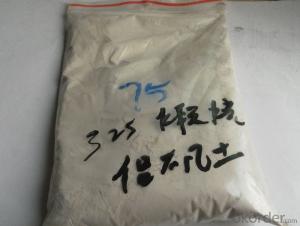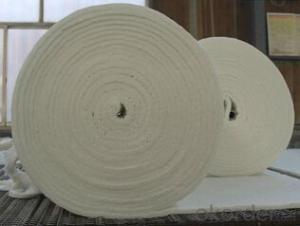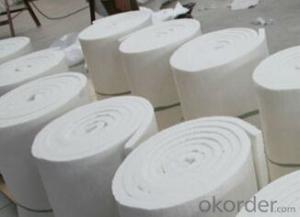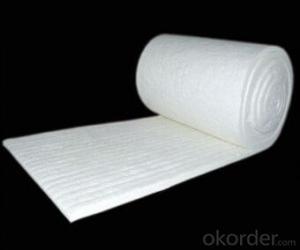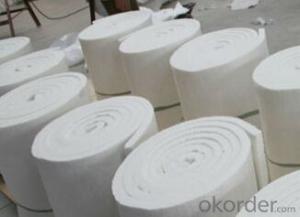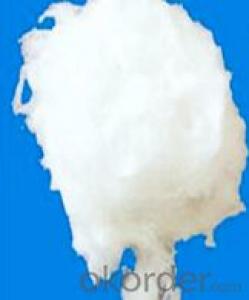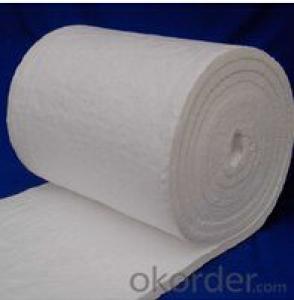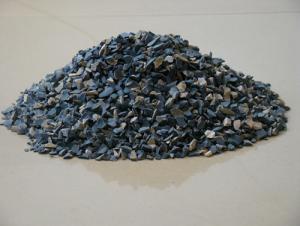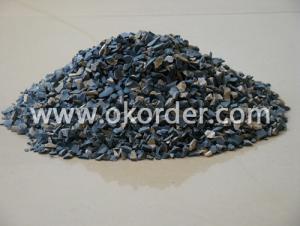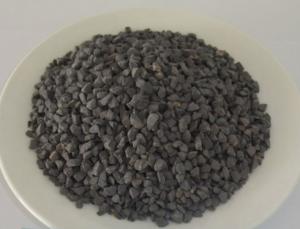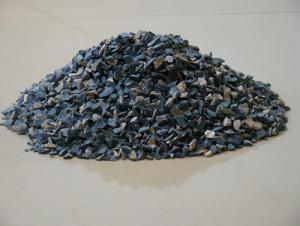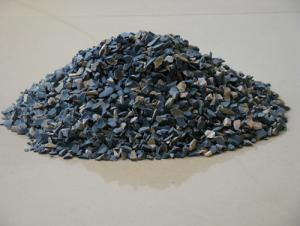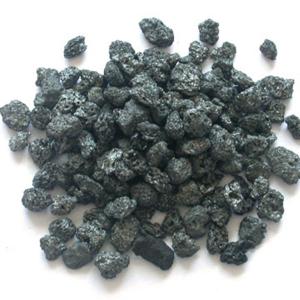Raw Materials for Refractory - White Ceramic Fiber Blanket
- Loading Port:
- China Main Port
- Payment Terms:
- TT OR LC
- Min Order Qty:
- -
- Supply Capability:
- -
OKorder Service Pledge
OKorder Financial Service
You Might Also Like
Specifications
1.Low thermal conductivity
2.No asbestos and anticorrosion.
3.Good flexibility , toughness
4.Excellent corrosion resistance.
Products Description
Needled-fiber blanket,made from common , high pure,high aluminium and zirconium alumina silicate
fiber bulk produced by blowing fiber forming technology, has undergone several processes including
needling , thermal forming, vertical and transverse slitting and rolling.
Needled-fiber blanket have even texture and smooth surface . Long fiber and low ball sediment,which
comprehensively improves the inter-weaving degree, delamination resistance,performance , wind
erosion resistance , flexibility and tensile strength of fiber. Therefore , the application property of
needled blankets is improved and material loss is cut down.
Typical Application
1.Industrial furnace, heating devices, high temperature pipe wall linings.
2.High temperature boilers, steam turbine and nuclear power thermal insulation.
3.Chemical industrial high-temperature reaction equipment and heating equipment wall linings.
4.High building fireproof and thermal insulation.
5.Furnace door and roof thermal insulation.
Specification
Grade | Common | Standard | High Pure | High Aluminium | Zirconium | |
Classification Temperature(°C) | 1000 | 1260 | 1260 | 1300 | 1430 | |
Working Temperature(°C) | ≤1000 | 1150 | 1200 | 1260 | 1400 | |
Density(kg/m3) | 96/128/160 | 96/128/160 | 96/128/160 | 128/160 | 128/160 | |
Compression strength(Mpa) | 0.5 | 0.5 | 0.5 | 0.5 | 0.5 | |
Chemical Composition (%) | Al2O3 | 44 | 46 | 47-49 | 52-55 | 39-40 |
Al2O3+SiO2 | 96 | 97 | 99 | 99 | - | |
Al2O3+SiO2+ZrO2 | - | - | - | - | 99 | |
ZrO2 | - | - | - | - | 15-17 | |
Fe2O3 | <1.2 | <1.0 | 0.2 | 0.2 | 0.2 | |
Na2O+K2O | ≤0.5 | ≤0.5 | 0.2 | 0.2 | 0.2 | |
Size (mm) | Other sizes and shapes on the working conditions | |||||
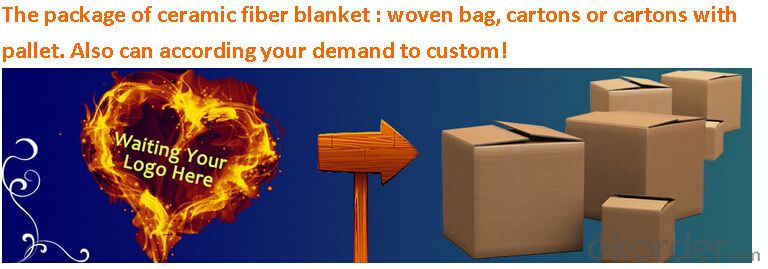
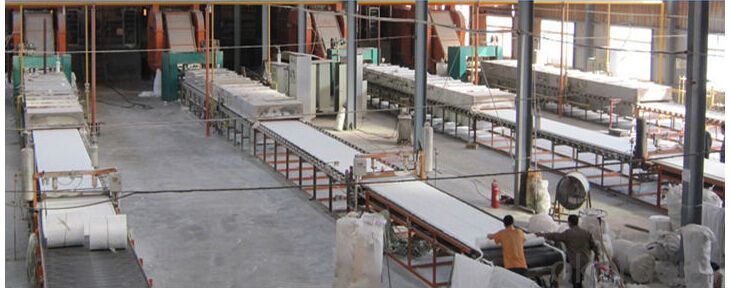
- Q: How much modulus is used as refractories material of sodium silicate.
- Storage and use are very convenient, especially for mechanized and the evenly refractory material and the sodium silicatemodulus is generally...2. transportation. The appearance of product is pure white. Instant powdered sodium silicate, also known as instant sodium metasilicate.4 to 3, in powder form, automation. in the range of 3, hydrated sodium silicate
- Q: What is the function of refractory material?
- Refractory is a basic material in the field of high temperature technology. Generally, the refractory is used as structural material or lining to resist high temperature in various thermal equipment and high temperature container. In the iron and steel industry and metallurgy industry, coke ovens are mainly composed of refractory materials. Various refractories that meet the requirements are essential in blast furnace for ironmaking, hot stove, all kinds of steel-making furnaces, soaking furnace and heating furnace. Not only the die casting for molten steel needs lots of refractory materials, but also the continuous casting needs some high-quality refractory materials. Without high-quality refractory materials, external refining is also not impossible to achieve. Statistics show that the steel industry is the sector that needs the most refractory. Pyrometallurgy and thermal processing of ferrous metal also needs refractories. All high-temperature furnaces or lining in construction materials industry or other high temperature industries that produce silicate products such as glass industry, cement industry, and ceramics industry must be constructed with refractory materials. All kinds of roasting funaces, sintering funaces, heating furnaces, boilers, flues, chimneys and protective layers in chemical, power and machinery manufacturing industry need refractories. In short, when some kind of structures, devices, equipments or vessels are used under high temperature, they all should utilize refractory to resist the high temperature because those materials will deform, soften and fuse or will be eroded, scoured or broken due to the physical, chemical, mechanical effects, which may stop the operation, affect the production, contaminate processed objects and impact the quality of products.
- Q: What is the role of the vermiculite fireproof material?
- The vermiculite fireproof slate is widely applied to construction, shipbuilding, metallurgy, electric power, aerospace and other fields by foreign countries. Vermiculite slate can be applied to furniture, firewall, ceiling, and can be used in the fire fighting access, coated steel, coated pipeline, real flame fireplace in the lining board, wall partition. It is characterized by non combustible, non melting, resistance to high temperature; permanent thermal insulation; sound insulation, non-toxic, smoke-free, green environmental protection; resistance to impact, good dimensional stability and durability of the excellent anti fungal infestation. It can be sawed, nailed, planed, drilled, it can be easily installed and constructed.
- Q: How to apply the alumina powder on refractories?
- The most common one in use is the refractory bricks.
- Q: What are grade classifications of the external walls for fireproofing?
- The basic level can be divided into: A1, A2, B1, B2, B3 and other levels. There are many technical indicators to make specific division, but I partly cannot report for a while, because it is very professional and technical. Please contact Qingdao Shanfang Instrument Co., LTD for details, they specialized in the external wall thermal insulation materials fire?rating testers.
- Q: What's the frequently used refractory material?
- Refractory material is generally used in industrial departments like metallurgy, glass, cement, ceramics, machinery, hot working, petrochemical industry, power and national defense. Frequently used common refractory: silica?brick, semi-silica brick, clay brick, high alumina brick, magnesia brick, etc. Frequently used special refractory: AZS brick, corundum brick, direct-bonded?magnesia-chrome?bricks, carborundum brick, calcium oxide, chromium hemitrioxide, alumina, magnesium oxide, etc. Frequently used fireclay insulating refractory: diatomite product, asbestos product, insulation?board, etc. Frequently used unshaped refractory: ramming refractory, refractory castable, plastic refractory, refractory mortar, gun-mix refractory, refractory coating, lightweight refractory?castables, etc.
- Q: What is the the best matching ratio of refractory cement?
- Refractory cement is very easy to use. Add some water and mix, and it will harden. Generally there is no need to add other binding agents, but you can add some refractory aggregate and powder. If you use only refractory cement, it will produce a lot of cracks after high temperature. Generally refractory cement can withstand temperature of about 1300 degrees. Refractory cement can be used together with ordinary sand, and the ratio of cement and the sand is about 30 percent.
- Q: What is neutral refractory? Can refractory suppliers tell the main components of it?
- The material using Al2O3, clay, bauxite and corundum as the main components is neutral material; the material using MgO and CaO as the main components is basic material; the material using SiO2 as th emain component is acidic material.
- Q: What is the fireproofing requirements of external wall thermal insulation materials?
- in the 2011 and 2012 revised version of "Fireproof? Specification of Building Design" in China, the external insulating layer of above 50 meters (approximately 16 layers) of the housing must use the level A material. The latest draft for approval is not so strict, above 100 meters (about 33 layers) only use level A material. The manuscript of "Building Regulations" is also regulated building's external wall thermal insulation materials in the crowded places should be level A. Except the residential buildings and the buildings in the crowded places, the height of other buildings is greater than 50 meters, combustion performance of insulation materials should be level A; the height buildings is greater than 24 meters but not more than 50 meters, combustion performance of insulation materials should not be lower than level B1. "Building Regulations" manuscript should relax the rules on the aspect of protective coating in level B1 and B2 insulation material. The outer of level B1 and B2 level insulation material must use incombustible?material as protective coating, its thickness is changed from the original 10 cm to 5 cm. Given certain conditions, I feel you can use TDD exterior wall thermal insulation decoration integrated rock wool board for construction, which is level A fireproofing with a short construction period and good thermal insulation properties. I hope I can help you!
- Q: Who knows about the types of Dalian thermal insulating and refractory materials?
- (1) rock wool board: the heat conductivity coefficient is 0.041-0.045. It is fire retardant, has a great temperature absorption while a poor thermal insulation performance. (2) glass wool: it is simple in construction and free in cutting. It has advantages of antibiosis, mould proof, aging resistance and anticorrosion, and can ensure a healthy environment. It has a low hygroscopicity and a stable physical property. (3) expanding polystyrene board(EPS board): thermal conductivity: 0.037-0.041, it has a good thermal insulation performance, cheap price but a poor intensity. (4) extruded polystyrene board(XPS board): thermal conductivity: 0.028-0.03, it has a better thermal insulation performance, high intensity, moisture resistance while it is expensive, and requires surface treatments during construction. (5) gelatine powder polyphenyl granule heat insulating slurry: heat conductivity coefficient: 0.057-0.06, it has a good flame resistance while a poor thermal insulation performance, as well as has high construction requirements and can be recycled. (6) polyurethane foam: heat conductivity coefficient: 0.025-0.028, it has advantages of waterproofness, thermal insulation, high intensity, high integrity, and good integrity, but it has a poor fireproof?performance and is more expensive. (7) rigid polyurethane: heat conductivity coefficient: 0.018-0.023, it has advantages of low heat conductivity coefficient and good thermal performance. When the unit weight of rigid polyurethane is 35 to 40kg per cubic meters, it is equivalent to half of the EPS. It is the one with the lowest heat conductivity coefficient among all the thermal insulation materials. (8) perlite slurry: heat conductivity coefficient: 0.07-0.09, it has advantages of fire and high-temperature resistance, and high water absorption but is poor in thermal insulation.
Send your message to us
Raw Materials for Refractory - White Ceramic Fiber Blanket
- Loading Port:
- China Main Port
- Payment Terms:
- TT OR LC
- Min Order Qty:
- -
- Supply Capability:
- -
OKorder Service Pledge
OKorder Financial Service
Similar products
Hot products
Hot Searches
Related keywords
